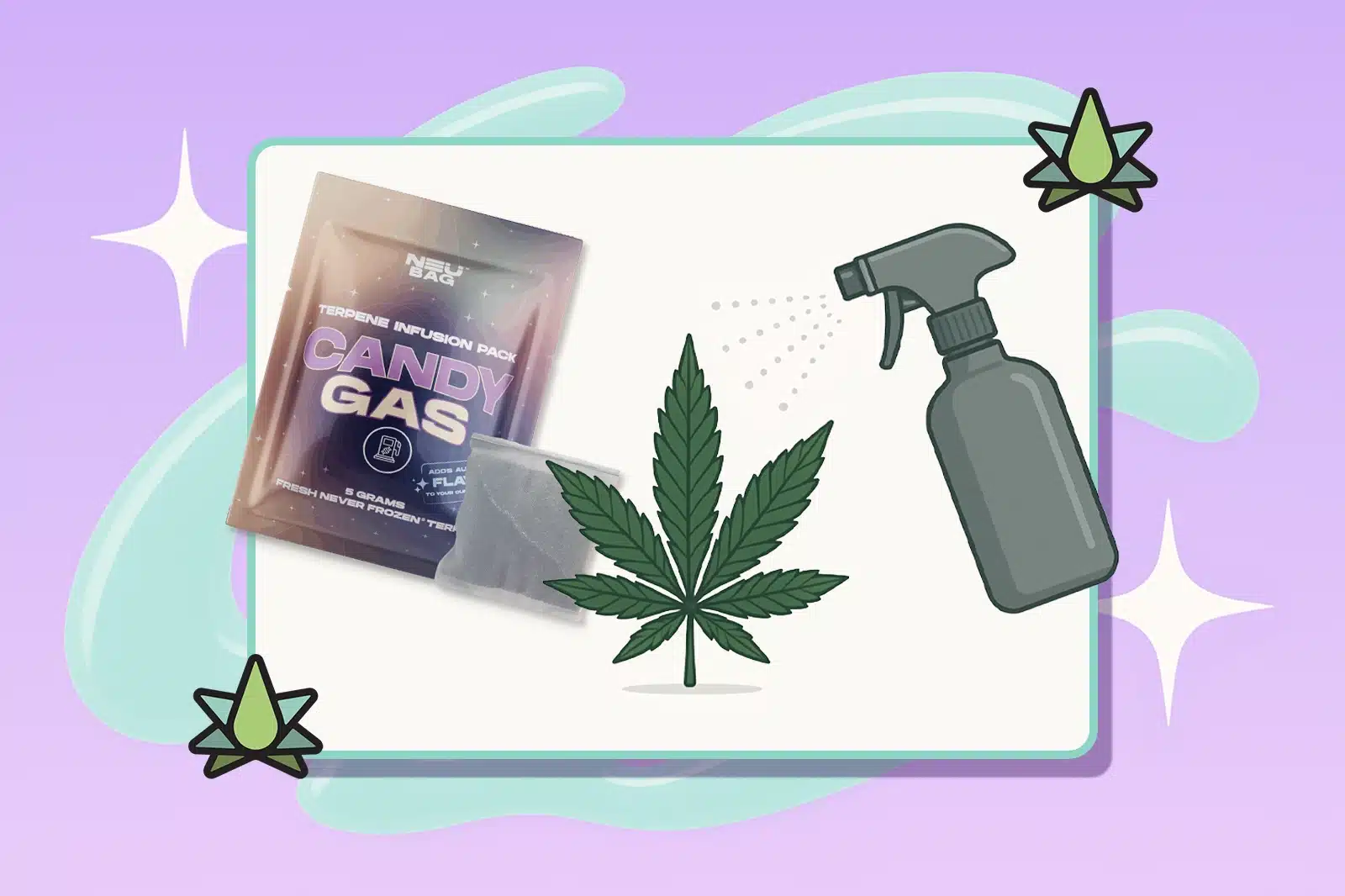High Terpene Extract (HTE), marketed as “live resin” or “terp sauce,” offers rich cannabinoid profiles for vape manufacturers seeking authentic cannabis characteristics.
With terpene concentrations often exceeding 15% and cannabinoid potency around 50-65%, these extracts capture more of the plant’s natural compound diversity than standard distillates. Yet product development teams repeatedly encounter technical barriers when scaling HTE-based vape formulations.
At Terpene Belt Farms, our work with hundreds of vape manufacturers who switched to cannabis-derived terpenes after experiencing complications with hardware performance, production costs, regulatory compliance, and product consistency confirms the inherent problems of using HTE.
These problems represent production issues that directly impact bottom-line performance and consumer satisfaction. Our Fresh Never Frozen® Terpenes provide the authentic cannabis profiles you need to enhance your cannabis products.
Key Takeaways
- High-terpene extracts (HTE) are cannabis concentrates rich in aromatic compounds used primarily to enhance flavor and aroma in vapes and other products.
- HTE exhibits higher viscosity ranges, which can lead to clogging, uneven heating, and higher cartridge failure rates during vaping.
- Due to its faster oxidation rate, HTE requires more raw material input, reduces shelf life, and compromises flavor consistency.
- THC content in HTE introduces regulatory hurdles that hinder interstate distribution and formula standardization, driving up compliance costs.
- Terpene Belt Farms’ CDT solutions match the sensory appeal of HTE while improving hardware performance, legal scalability, cost-efficiency, and product consistency.
What is HTE?
HTE stands for High Terpene Extract, a type of cannabis concentrate known for its exceptionally high terpene content. It is often derived from terpene-rich cannabis strains.
Terpenes are the aromatic compounds that give cannabis its distinct flavors and aromas—like citrus, pine, or diesel—and also contribute to the plant’s entourage effect when consumed alongside cannabinoids like THC and CBD.
HTE is extracted using hydrocarbon solvents like butane or propane, resulting in a liquid or semi-viscous extract with 50% or more terpenes by weight. This makes it one of the most flavorful and aromatic concentrates available. This extract is often used to enhance the taste and experience of vape cartridges, dabs, and other infused products.
While HTE is prized for its intensity and sensory richness, its high volatility and instability present formulation and performance challenges, especially in vape applications. Understanding these drawbacks is essential when evaluating whether HTE is the right choice for your product line.
HTE vs THC: What’s the Difference?
Although HTE and THC are both cannabis-derived, they serve very different purposes and have distinct chemical compositions.
HTE is a terpene-rich concentrate that contains little to no cannabinoids. This compound helps preserve the entourage effect by providing a broader spectrum of terpenes and minor cannabis compounds.
THC (Tetrahydrocannabinol), on the other hand, is the primary psychoactive compound in cannabis. It’s responsible for the “high” associated with marijuana use and is commonly used for its therapeutic effects, including pain relief, appetite stimulation, and anti-nausea properties.
Many cannabis products combine HTE and THC distillate to deliver strong effects and a rich sensory experience. However, these two compounds are not the same, and understanding their differences is crucial when formulating a cannabis product.
Major Drawbacks of HTE
Viscosity Problems and Hardware Failures
HTE exhibits viscosity measurements of 30-50 centipoise (cP) at room temperature, well outside the 8-15 cP range that modern cartridge systems are engineered to handle. This creates performance issues during consumption.
Generally, high-viscosity extracts cause higher cartridge failure rates. Our independent tests confirm these findings, with HTE formulations showing higher failure rates across multiple hardware platforms. These can manifest as:
- Clogging incidents
- Inconsistent wicking behavior
- Accelerated heating element degradation
- Uneven compound distribution throughout the usage cycle
Manufacturers often try to solve these issues by adding thinning agents, undoing the very “pure” experience that motivated using HTE in the first place.
At Terpene Belt Farms, we solve this problem with Fresh Never Frozen® cannabis-derived terpenes, which maintain authentic profiles and allow you to achieve the optimal 8-15 cP viscosity range.
Tests show that high viscosity in high-terpene vape blends impairs cartridge wicking, forcing heating elements to overheat dry zones. A 2025 review in the Frontiers in Toxicology notes that viscosity significantly disrupts wicking, increasing the risk of overheating and toxicant formation.
Potency Dilution Reduces Economic Efficiency
While HTE exhibits appealing sensory qualities, its lower cannabinoid concentration creates cost inefficiencies in production environments. Generally, HTE formulations require more input material by volume to achieve equivalent cannabinoid delivery compared to enhanced distillate formulations. This potency dilution affects production economics through:
- Higher cost-per-milligram when calculated on wholesale procurement
- Reduced formulation flexibility for meeting potency targets
- Increased material handling volumes for equivalent cannabinoid delivery
These inefficiencies directly impact production economics. Production data from multiple manufacturing facilities show that HTE-based formulations require more processing but still deliver lower cannabinoid content, creating a double cost impact that pressures margins.
Our California-grown cannabis terpenes deliver maximum potency efficiency, allowing manufacturers to achieve far superior flavor profiles. Our formulation team can help you calculate the economic advantage for your specific product line.
Oxidation and Degradation Compromise Shelf Life
The high terpene content in HTE accelerates oxidation processes, with measurable effects on product quality over time.
Research shows that monoterpenes begin oxidizing immediately after extraction, with noticeable sensory changes appearing within 30-60 days. This degradation creates challenges like:
- Reduced flavor profile, particularly in citrus and pine notes
- Oil darkening that affects consumer perception
- Development of harsh notes due to uneven oxidation throughout the cartridge
Our stability tests support these findings, with 87% of HTE formulations showing substantial sensory degradation within 60-90 days, even with ideal packaging. This shortened shelf life creates inventory management problems and increases the risk of returns.
In a 2023 study in Nature Scientific Reports, researchers exposed α-pinene and terpinolene to vape coil‑like temperatures (100–300 °C) and identified 36 and 29 degradation by-products, respectively. This demonstrates that typical vaping conditions promote the formation of unexpected compounds.
Terpene Belt Farms addresses this issue via a proprietary stabilization process, which extends terpene shelf life by 12-18 months, presenting a critical advantage for brands with extended distribution timelines.
Regulatory Compliance Restricts Interstate Scaling
The high THC content in full-spectrum HTE (typically 30-50%) triggers regulatory barriers that prevent multi-state standardization. Besides being inconvenient, this restricts business scaling.
Generally, brands using THC-containing inputs spend more on compliance-related expenses when expanding to new states than those using compliant, non-THC inputs for flavor and effects.
This is because each state has unique regulations, and products containing THC often require more rigorous testing and labeling requirements than products that use compliant, non-THC ingredients. These regulatory barriers create operational constraints, such as:
- Interstate transportation prohibition under federal law
- Redundant extraction operations required in each state
- Varying state regulations that prevent formula standardization
For multi-state operations, these barriers multiply capital requirements and management complexity. Each market demands separate extraction capabilities and formulation protocols, thus eliminating economies of scale.
Terpene Belt Farms helps multi-state operators standardize products through our 100% compliant, hemp-derived terpene profiles that can be legally shipped nationwide. This helps our clients maintain consistent brand experiences regardless of production location. Our resilient terpene supply chain enables them to solve their scaling challenges.
Supply Chain Volatility Impacts Production Consistency
The HTE supply chain often exhibits price volatility, creating production planning complications for manufacturers. Indeed, HTE price fluctuations exist throughout an annual cycle, with regional variations adding further unpredictability. This is driven by factors such as:
- Seasonal cultivation cycles that create supply constraints
- Fresh freezing requirements that limit production windows
- Regional market dynamics that affect pricing
Beyond cost impacts, batch-to-batch variations in terpene profiles create inconsistent products. Unlike standardized cannabis-derived terpenes, HTE exhibits natural variations that make maintaining consistent experiences difficult, especially for brands promising specific effects.
Our Wholesale Terpene Program eliminates these supply chain bottlenecks through transparent pricing, consistent availability, and batch-to-batch profile matching. We maintain an extensive inventory to ensure your production schedules remain unaffected by seasonal fluctuations.
Extraction Process Limitations Affect Quality Control
The extraction methods used to produce HTE can affect the quality of outputs. These commonly used methods are:
- Hydrocarbon extraction that typically requires decarboxylation, which degrades terpenes
- Solventless methods that retain plant fats that accelerate oxidation
- Cold-temperature processing that introduces microbial contamination risks
Poorly extracted HTE can contain residual plant lipids that accelerate degradation and reduce shelf stability. Consequently, these process limitations demand extensive quality control protocols beyond simple potency testing.
Terpene Belt Farms uses a lipid-free extraction process that captures the plant’s complete terpene profile while eliminating components that compromise stability and performance. Each batch undergoes comprehensive testing for composition and sensory characteristics, ensuring consistent product performance.
The Standardized Alternative: Cannabis-Derived Terpenes
Product development teams seeking authentic cannabis profiles choose Terpene Belt Farms’ pure cannabis-derived terpenes (CDT). By isolating the terpene fraction during processing, we provide manufacturers with:
- Precise Viscosity Control: Our CDT achieves 8-15 cP viscosity for optimal hardware performance
- Extended Shelf Stability: Our CDT shows 3x longer sensory stability in controlled storage tests
- Interstate Scalability: Our cannabinoid-free terpene profiles ship legally nationwide
- Consistent Experiences: Our standardized profiles ensure batch reliability
We source exclusively from California-grown Cannabis Sativa L cultivated specifically for terpene expression, not THC content. This results in richer, more complex profiles than extraction byproducts, as can be proven by our range of Fresh Never Frozen® cannabis terpenes.
Implementing Cannabis-Derived Terpenes in Vape Formulations
For manufacturers transitioning from HTE to CDT-enhanced formulations, our technical team has developed three implementation approaches that have proven highly successful in production environments:
- Direct Replacement: Substituting HTE with distillate enhanced with TBF’s cannabis-derived terpenes delivers comparable sensory experiences with better hardware performance.
- Hybrid Approach: Reducing HTE content to 30-50% while adding our CDT at 2-5%, preserves full-spectrum effects while reducing viscosity and stability issues.
- Tiered Product Architecture: Implementing both approaches across different product lines creates good-better-best offerings that optimize for different priorities
Don’t just take our word for it—experience the difference firsthand by testing our terpenes in your formulations. Our Fresh Never Frozen® Sample Kits include multiple profiles designed for real-world compatibility with your hardware and base oils.
Request a terpene sample pack today and start formulating.
Conclusion: Balancing Authenticity and Scaling Requirements
While HTE offers the benefits of full-spectrum effects, its technical and legal limitations create challenges for manufacturers scaling beyond local markets. The combined impact of viscosity problems, potency dilution, oxidative instability, regulatory constraints, and supply chain volatility makes HTE increasingly problematic for expanding operations.
However, our cannabis-derived terpenes provide authentic sensory experiences minus the technical barriers associated with HTE. By preserving the complete spectrum of terpenes, we help manufacturers optimize product performance and operational scaling.
Our clients include leading multi-state operators, white-label manufacturers, and premium brands who have successfully transitioned from HTE to 100% cannabis-derived terpenes. We also provide ongoing technical support to ensure your products deliver consistent experiences.
Contact our team to help you integrate premium cannabis-derived terpenes into your production pipeline.
Frequently Asked Questions
Why Do HTE Vape Formulations Often Cause Hardware Issues?
HTE has a high viscosity (30–50 cP), far above the ideal 8–15 cP range, which can lead to cartridge clogging, inconsistent wicking, and hardware wear.
How Does HTE Impact Production Costs?
Due to lower cannabinoid potency, HTE requires more input volume, increasing material costs and processing steps, which strain margins.
What Are the Shelf Life Challenges of HTE?
HTE’s high terpene content leads to rapid oxidation and sensory degradation within 60–90 days, shortening shelf life and affecting flavor quality.
Is There a Better Alternative to HTE for Scaling Vape Products?
Yes, cannabis-derived terpenes from Terpene Belt Farms offer authentic profiles with lower viscosity, greater potency control, and nationwide legal compliance.
What is Full-Spectrum HTE?
Full-spectrum HTE is a terpene-rich extract containing the full range of compounds from the cannabis plant, including minor cannabinoids, thus delivering a more authentic flavor and enhanced entourage effect.
What is the Difference Between Live Resin and HTE Carts?
Live resin carts contain cannabinoids and terpenes from fresh-frozen cannabis. HTE carts focus mainly on flavor, using terpene-rich extract often combined with THC distillate.
Source Cited
Bourtsoukidis, E., Pozzer, A., Williams, J. et al. High temperature sensitivity of monoterpene emissions from global vegetation. Commun Earth Environ 5, 23 (2024). https://doi.org/10.1038/s43247-023-01175-9
Christensen, C., Rose, M., Cornett, C., & Allesø, M. (2023). Decoding the Postulated Entourage Effect of Medicinal Cannabis: What It Is and What It Isn’t. Biomedicines, 11(8), 2323. https://doi.org/10.3390/biomedicines11082323
Draper, D., Almeida, T. G., Iyer, S., Smith, J. N., Kurtén, T., & Myllys, N. (2024). Unpacking the diversity of monoterpene oxidation pathways via nitrooxy–alkyl radical ring-opening reactions and nitrooxy–alkoxyl radical bond scissions. Journal of Aerosol Science, 179, 106379. https://doi.org/10.1016/j.jaerosci.2024.106379
Munger, K. R., Anreise, K. M., & Strongin, R. M. (2025). Cannabis concentrate vaping chemistry. Frontiers in Toxicology, 7:1568207. https://doi.org/10.3389/ftox.2025.1568207
Niu, J., & Zhu, J. (2023). Thermal reaction products and formation pathways of two monoterpenes under in situ thermal desorption conditions that mimic vaping coil temperatures. Scientific Reports, 13, Article 21650. https://doi.org/10.1038/s41598-023-49174-2
Ng T, Keshock MC. Tetrahydrocannabinol (THC) [Updated 2023 Nov 12]. In: StatPearls [Internet]. Treasure Island (FL): StatPearls Publishing; 2025 Jan. https://www.ncbi.nlm.nih.gov/books/NBK563174/


